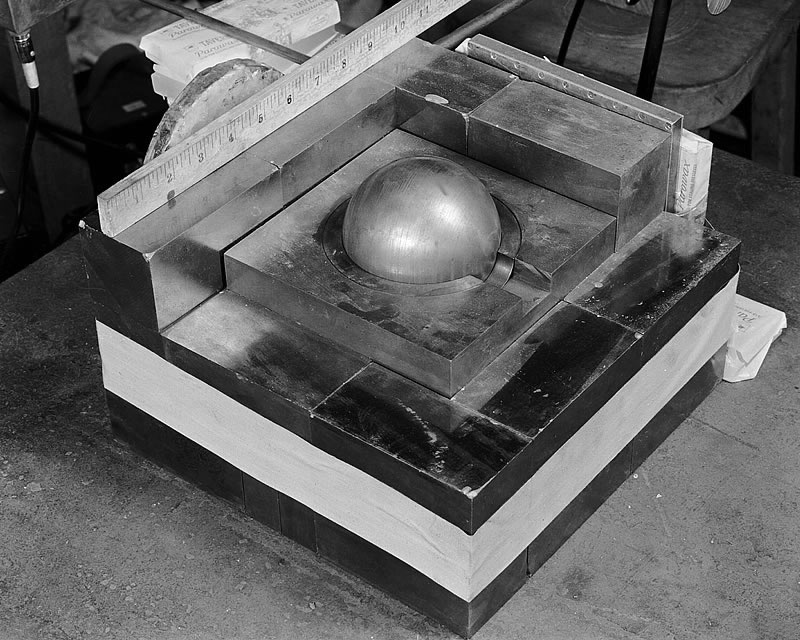|
Demon Core
The demon core was a spherical subcritical mass of plutonium in diameter, manufactured during World War II by the United States nuclear weapon development effort, the Manhattan Project, as a fissile core for an early atomic bomb. The core was prepared for shipment as part of the third nuclear weapon to be used in Japan, but when Japan surrendered, the core was retained at Los Alamos for testing and potential later use. It was involved in two criticality accidents at the Los Alamos Laboratory on August 21, 1945, and May 21, 1946, each resulting in a fatality. Both experiments were designed to demonstrate how close the core was to criticality with a tamper, but in each case, the core was accidentally placed into a supercritical configuration. Physicists Harry Daghlian and Louis Slotin suffered acute radiation syndrome (ARS) and died soon after, while others present in the lab were also exposed. Manufacturing and early history The demon core (like the second core used i ... [...More Info...] [...Related Items...] OR: [Wikipedia] [Google] [Baidu] |
Plutonium–gallium Alloy
Plutonium–gallium alloy (Pu–Ga) is an alloy of plutonium and gallium, used in nuclear weapon pits, the component of a nuclear weapon where the fission chain reaction is started. This alloy was developed during the Manhattan Project. Overview Metallic plutonium has several different solid allotropes. The δ phase is the least dense and most easily machinable. It is formed at temperatures of 310–452 °C at ambient pressure (1 atmosphere), and is thermodynamically unstable at lower temperatures. However, plutonium can be stabilized in the δ phase by alloying it with a small amount of another metal. The preferred alloy is 3.0–3.5 mol.% (0.8–1.0 wt.%) gallium. Pu–Ga has many practical advantages: * stable between −75 to 475 °C, * very low thermal expansion, * low susceptibility to corrosion (4% of the corrosion rate of pure plutonium), * good castability; since plutonium has the rare property that the molten state is denser than the solid state, the tendenc ... [...More Info...] [...Related Items...] OR: [Wikipedia] [Google] [Baidu] |
Los Alamos Science
''Los Alamos Science'' was the Los Alamos National Laboratory's flagship publication in the years 1980 to 2005. Its main purpose was to present the laboratory's research and its significance to national security to the scientific community, and US government policymakers. Special issues appeared on subjects such as particle physics, Stanislaw Ulam, and the Human Genome Project The Human Genome Project (HGP) was an international scientific research project with the goal of determining the base pairs that make up human DNA, and of identifying, mapping and sequencing all of the genes of the human genome from both a .... "Pedagogical articles" were intended to explain difficult concepts in one field to scientists and students in other fields. References Science and technology magazines published in the United States Magazines established in 1980 Magazines disestablished in 2005 Defunct magazines published in the United States Biannual magazines published in the United ... [...More Info...] [...Related Items...] OR: [Wikipedia] [Google] [Baidu] |
Nickel
Nickel is a chemical element with symbol Ni and atomic number 28. It is a silvery-white lustrous metal with a slight golden tinge. Nickel is a hard and ductile transition metal. Pure nickel is chemically reactive but large pieces are slow to react with air under standard conditions because a passivation layer of nickel oxide forms on the surface that prevents further corrosion. Even so, pure native nickel is found in Earth's crust only in tiny amounts, usually in ultramafic rocks, and in the interiors of larger nickel–iron meteorites that were not exposed to oxygen when outside Earth's atmosphere. Meteoric nickel is found in combination with iron, a reflection of the origin of those elements as major end products of supernova nucleosynthesis. An iron–nickel mixture is thought to compose Earth's outer and inner cores. Use of nickel (as natural meteoric nickel–iron alloy) has been traced as far back as 3500 BCE. Nickel was first isolated and classified a ... [...More Info...] [...Related Items...] OR: [Wikipedia] [Google] [Baidu] |
Hot Pressing
Hot pressing is a high-pressure, low-strain-rate powder metallurgy process for forming of a powder or powder compact at a temperature high enough to induce sintering and creep processes. This is achieved by the simultaneous application of heat and pressure. Hot pressing is mainly used to fabricate hard and brittle materials. One large use is in the consolidation of diamond-metal composite cutting tools and technical ceramics. The densification works through particle rearrangement and plastic flow at the particle contacts. The loose powder or the pre-compacted part is in most of the cases filled to a graphite mould that allows induction or resistance heating up to temperatures of typically . Pressures of up to can be applied. Other great use is in the pressing of different types of polymers. Within hot pressing technology, three distinctly different types of heating can be found in use: induction heating, indirect resistance heating and field assisted sintering technique ... [...More Info...] [...Related Items...] OR: [Wikipedia] [Google] [Baidu] |
Allotropes Of Plutonium
Plutonium occurs in a variety of allotropes, even at ambient pressure. These allotropes differ widely in crystal structure and density; the α and δ allotropes differ in density by more than 25% at constant pressure. Overview Plutonium normally has six allotropes and forms a seventh (zeta, ζ) under high temperature and a limited pressure range. These allotropes have very similar energy levels but significantly varying densities and crystal structures. This makes plutonium very sensitive to changes in temperature, pressure, or chemistry, and allows for dramatic volume changes following phase transitions. Unlike most materials, plutonium ''increases'' in density when it melts, by 2.5%, but the liquid metal exhibits a linear decrease in density with temperature. Densities of the different allotropes vary from 16.00 g/cm3 to 19.86 g/cm3. Machining plutonium The presence of these many allotropes makes machining plutonium very difficult, as it changes state very readily ... [...More Info...] [...Related Items...] OR: [Wikipedia] [Google] [Baidu] |
Washington State
Washington (), officially the State of Washington, is a state in the Pacific Northwest region of the Western United States. Named for George Washington—the first U.S. president—the state was formed from the western part of the Washington Territory, which was ceded by the British Empire in 1846, by the Oregon Treaty in the settlement of the Oregon boundary dispute. The state is bordered on the west by the Pacific Ocean, Oregon to the south, Idaho to the east, and the Canadian province of British Columbia to the north. It was admitted to the Union as the 42nd state in 1889. Olympia is the state capital; the state's largest city is Seattle. Washington is often referred to as Washington state to distinguish it from the nation's capital, Washington, D.C. Washington is the 18th-largest state, with an area of , and the 13th-most populous state, with more than 7.7 million people. The majority of Washington's residents live in the Seattle metropolitan area, the center of ... [...More Info...] [...Related Items...] OR: [Wikipedia] [Google] [Baidu] |
Hanford Site
The Hanford Site is a decommissioned nuclear production complex operated by the United States federal government on the Columbia River in Benton County in the U.S. state of Washington. The site has been known by many names, including SiteW and the Hanford Nuclear Reservation. Established in 1943 as part of the Manhattan Project, the site was home to the Hanford Engineer Works and B Reactor, the first full-scale plutonium production reactor in the world. Plutonium manufactured at the site was used in the first atomic bomb, which was tested in the Trinity nuclear test, and in the Fat Man bomb that was used in the bombing of Nagasaki. During the Cold War, the project expanded to include nine nuclear reactors and five large plutonium processing complexes, which produced plutonium for most of the more than sixty thousand weapons built for the U.S. nuclear arsenal. Nuclear technology developed rapidly during this period, and Hanford scientists produced major technologi ... [...More Info...] [...Related Items...] OR: [Wikipedia] [Google] [Baidu] |
Refining (metallurgy)
In metallurgy, refining consists of purifying an impure metal. It is to be distinguished from other processes such as smelting and calcining in that those two involve a chemical change to the raw material, whereas in refining, the final material is usually identical chemically to the original one, only it is purer. The processes used are of many types, including pyrometallurgical and hydrometallurgical techniques. Lead Cupellation One ancient process for extracting the silver from lead was cupellation. Lead was melted in a bone ash 'test' or 'cupel' and air blown across the surface. This oxidised the lead to litharge, and also oxidised other base metals present, the silver (and gold if present) remaining unoxidised. In the 18th century, the process was carried on using a kind of reverberatory furnace, but differing from the usual kind in that air was blown over the surface of the molten lead from bellows or (in the 19th century) blowing cylinders. Pattinson process ... [...More Info...] [...Related Items...] OR: [Wikipedia] [Google] [Baidu] |
Louis Slotin & Harry K , names sometimes translated to English as "Louis"
{{disambiguation ...
Louis may refer to: * Louis (coin) * Louis (given name), origin and several individuals with this name * Louis (surname) * Louis (singer), Serbian singer * HMS ''Louis'', two ships of the Royal Navy See also Derived or associated terms * Lewis (other) * Louie (other) * Luis (other) * Louise (other) * Louisville (other) * Louis Cruise Lines * Louis dressing, for salad * Louis Quinze, design style Associated names * * Chlodwig, the origin of the name Ludwig, which is translated to English as "Louis" * Ladislav and László - names sometimes erroneously associated with "Louis" * Ludovic, Ludwig, Ludwick, Ludwik Ludwik () is a Polish given name. Notable people with the name include: * Ludwik Czyżewski, Polish WWII general * Ludwik Fleck (1896–1961), Polish medical doctor and biologist * Ludwik Gintel (1899–1973), Polish-Israeli Olympic soccer play ... [...More Info...] [...Related Items...] OR: [Wikipedia] [Google] [Baidu] |
Holloman Air Force Base
Holloman Air Force Base is a United States Air Force base established in 1942 located six miles (10 km) southwest of the central business district of Alamogordo, and a census-designated place in Otero County, New Mexico, United States. The base was named in honor of Col. George V. Holloman, a pioneer in guided missile research. It is the home of the 49th Wing (49 WG) of the Air Education and Training Command (AETC). In addition to hosting several combat wings, Holloman supports the nearby White Sands Missile Range and currently hosts the Royal Air Force RPAS (Remotely Piloted Aircraft System) Formal Training Unit (FTU) and the Italian Air Force RPA training courses. The base previously hosted the German Air Force Flying Training Center. History Planned for the British Overseas Training program which they did not pursue, construction for the USAAF base west of Alamogordo, New Mexico, began on 6 February 1942. After the nearby Alamogordo Bombing and Gunnery Range w ... [...More Info...] [...Related Items...] OR: [Wikipedia] [Google] [Baidu] |



_150_kbar_region.png)


